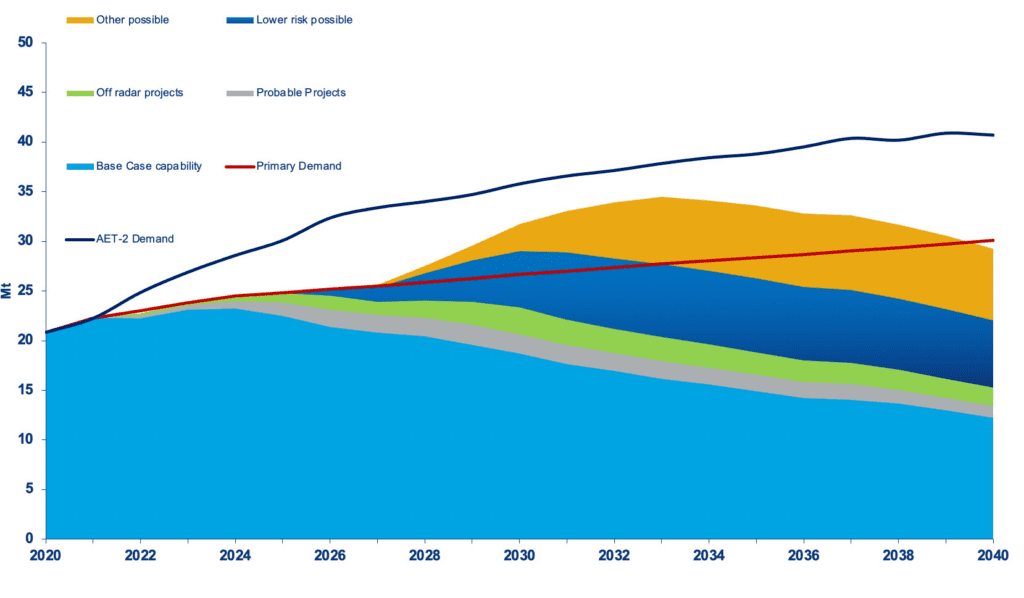The move to a low-carbon world (the energy transition) brings with it the prospect of transformational demand. This then leads inexorably to the challenge of supply development, which is a perennial problem for copper. In this article, we discuss the mismatch between the rhetoric on energy transition demand and the reality of supply development. Are there sufficient projects to meet the energy transition demand? What are the enablers of and constraints on supply? And is there a pathway to meeting demand or will transformational demand be illusionary?
Firstly, what is meant by the energy transition?
The energy transition currently underway is the move away from fossil fuels towards renewable and clean sources of energy (solar, wind and hydro). COVID-19 and massive stimulus programmes have accelerated plans for decarbonization, and much of the stimuli is green tinged, i.e. linked to carbon-reduction performance.
Powering the energy transition is a technology based switch from fossil fuels to renewables, supported by an almost ubiquitous societal push towards a sustainable future. There are two primary enablers – renewables and electrification. But they are out of kilter. Renewables growth is well ahead of electrification trends but, in time, the two will converge, welcoming the future of alternative energy. The global energy transition is unstoppable, but uncertainty remains in terms of timing, policy push and pull, etc.
Copper’s role in the energy transition
Copper is used across a range of economic early-cycle, mid-cycle, and late-cycle applications. Population increases and urbanization have historically been key drivers of copper consumption growth, boosting copper demand in new housing, power infrastructure, and consumer goods as newly urbanized residents fill their homes with household appliances.
These factors only tell half of the story. To complete the picture, we need to look at the copper intensity of growth and end-use applications. This is where the opportunity with the energy transition lies – the contribution of copper intensive sectors to GDP growth, and new growth markets for copper.
Electrification is front and centre in the energy transition. The entire power value chain – from wind turbines and solar panels, transmission and distribution infrastructure, to energy storage and batteries, and electric vehicle charging – will be a winner. Electrical applications are the primary source of growth, and their applications are what dominate copper’s energy transition opportunities.
Copper will benefit from higher intensity of copper use in certain applications. One example is hybrid and electric vehicles, which use typically two to three times more copper than internal-combustion-engine vehicles. Specific uses include motor windings, wiring harnesses, battery connectors, and the batteries themselves. Requirements for related charging infrastructure will add to copper usage.
Electricity generation, transmission, and distribution will be markedly different. Generation itself will become more copper intensive, reflecting increased adoption of renewable energy, which include wind and solar power that are significantly more copper intensive than conventional coal-fired power plants. With the whole grid “going green”, there will be a requirement to connect the generation sites with the urban and industry sites. This will be a win for copper in the transmission and distribution network. Additional support for copper demand will come as networks expand to meet demand for electrification.
In any scenario, copper will play a pivotal role in the energy transition, with demand for copper going up. Although, it should be remembered that copper has an abundant and cheap competitor in aluminium, but one with a carbon footprint issue for a primary metal.
Whether copper (or aluminium) wins in the energy transition electrification battle is something of a moot point as both commodities will experience rapid growth in power generation, transmission, distribution storage, and motive uses. Simply put, the energy transition cannot happen without a sufficient, timely, and ESG-compliant copper (and aluminium) supply in place.
Under the Wood Mackenzie Energy Transition Outlook (ETO) , demand for primary copper is set to grow by an average of ~2% p.a. over the next 20 years, representing an incremental rise of ~9Mt over the period. Under Wood Mackenzie’s Accelerated Energy Transition “AET-2” scenario , which limits the average Global temperature increase to 2-degrees from 1990 levels, there is the potential to boost copper demand growth to 3.5% p.a., leading to a doubling of global primary demand by 2040 (a further 10Mt above the ETO outlook).

Can primary supply grow fast enough to meet this challenge?
Grade decline and depletions (closures) are an ongoing feature of copper mining. Without additional investment in supply this ultimately leads to output declining.
Currently, we estimate that the industry has committed around US$120B in Capex to expand production to offset the impact of grade decline and depletions and raise output. Nonetheless without additional substantial investment production will decline from 2024 onwards. This decline in output, together with ETO demand growth, leads to a theoretical shortfall of ~16Mt by 2040 and requires an investment of an additional ~US$325B. Under our AET-2 scenario this investment explodes, reached more than US$0.5T.
The industry is not investing enough to meet burgeoning requirements, due in part to what happened in the last super-cycle where miners were generally poor at capital allocation with ill-timed expansions, capital over-runs and delayed project delivery so investors have taken a “once bitten, twice shy” approach.
And its also not getting any easier to develop a copper mine for several reasons:
- Project pipeline:
While the pipeline appears well populated, many possible projects have been development “opportunities” for a long time; and the near-term probable project pipeline is thin by historical standards. There are now ~35 uncommitted probable projects remaining, totalling ~1.7 Mtpa of copper. This compares to 5 Mtpa from 60 probable projects in the pipeline ~10 years ago, prior to the last boom in copper project development. - Capital intensity:
Looking at the future project pipeline, the upward trend in capital intensities appears to steepen quite significantly. However, it’s worth remembering that this population includes projects that are so capital intensive that they will never get built, or if they do get built, it’s
likely to be under a substantially different scope. - ESG requirements:
These are becoming increasingly stringent extending project lead times and risks. However, mining companies are ingenous if they want to develop a project. And ESG is bringing its own ingenuity to new developments – albeit part of why capex is going up – such as mines requiring desalination plants rather than drawing from the in-ground water at the mine site.
Other ways in which miners are bringing down costs recently has been willingness shown by some miners to consider infrastructure sharing may help to bring down costs in some cases. And a shift towards a phased development approach may also facilitate the development of some projects that would otherwise struggle to attract investment.
The energy transition cannot happen without a sufficient, timely, and ESG-compliant copper (and aluminium) supply in place
Is it plausible for supply to meet the energy transition demand requirements?
We assume that our base case supply growth is a given. Probable projects also proceed and come online as envisaged. Following ten years of the last super cycle off-radar projects accounted for 14% of supply by 2014. On the basis of a forecast of a rapid acceleration of demand growth spurred by the energy transition and elevated prices, we have allowed for off-radar projects to add an additional 15% to supply over the next ten years, a peak of ~2.9 Mtpa. Given high hurdle rates, rising ESG requirements, low risk appetite and associated extended lead times we assume that 50% of the 15 Mtpa of possible projects are greenlighted with production start delayed by an average of three years compared to the normally assumed earliest possible date. For the balance of the possible projects, which total a peak of we allow a further two years of slippage to production start.
The analysis paints a picture of a market able to meet base case market requirements from base case, highly probable and off-radar projects until mid-decade. Beyond this period, lower risk possible projects can meet requirements until the mid-2030s. The key question remains whether these projects will be greenlighted given that many of them have been on the drawing boards for years if not decades.
An AET-2 demand growth trajectory stresses supply elasticity almost immediately with deficits ballooning to a potential 6.5Mt by 2027 as supply is unable to meet demand requirements. Even allowing for all probable projects to be developed (albeit delayed) supply would be unable to meet AET-2 requirements thereby becoming a constraint on an accelerated energy transition.
The lack of supply development could come back to bite the copper industry. All things going according to plan, it takes around eight years to develop a mine – on average – and four years to build the mine. The time to get going with projects is now. This may require investing through the cycle, as we enter a period of market oversupply, should balance sheets be able to take it.
The lack of project development has obvious implications for prices which could remain in demand destruction territory for long enough to damage the market for copper.
Of course, there could be a solution to the conundrum and that is greater availability and use of scrap metal but resolving the challenges there requires a massive policy shift and societal change – neither of which will see quick results.












